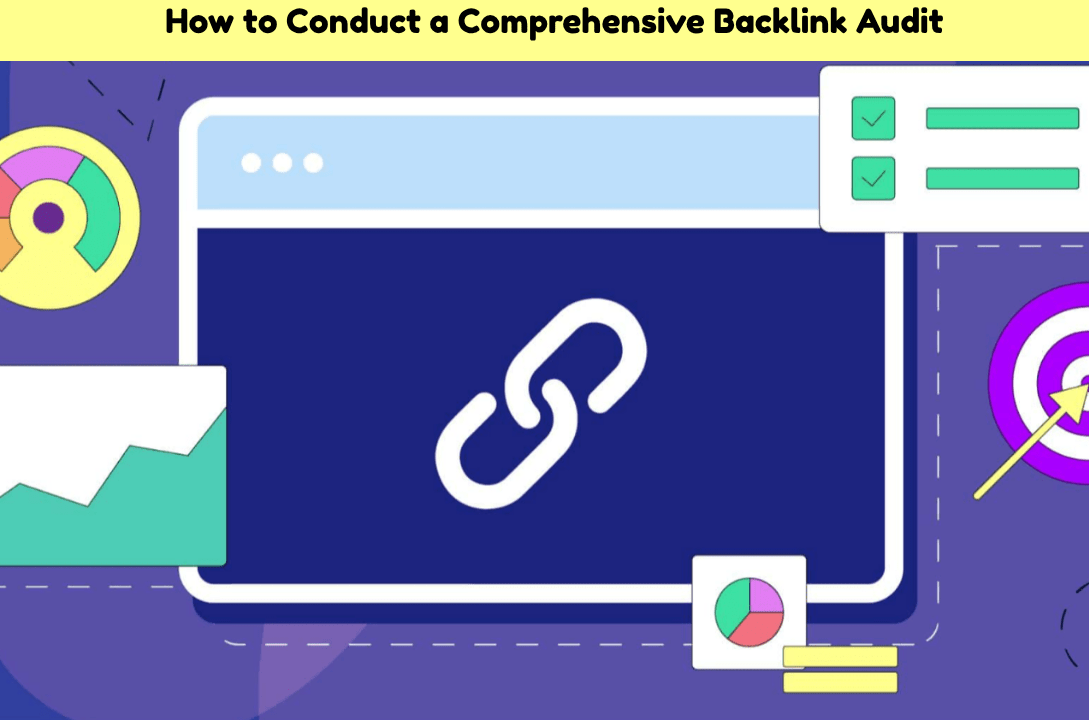A backlink audit is a crucial process for anyone looking to improve their website’s search engine optimization (SEO) and online visibility. Backlinks—links from other websites pointing to your site—are like votes of confidence in the eyes of search engines like Google. However, not all backlinks are helpful; some can harm your site’s rankings if they’re low-quality or spammy. Conducting a comprehensive backlink audit helps you understand your backlink profile, identify issues, and optimize your SEO strategy. This 1500-word article is designed to be unique, SEO-friendly, beginner-friendly, and easy to understand, guiding you through the key elements of a thorough backlink audit.
What Is a Backlink Audit and Why Is It Important?
A backlink audit is the process of analyzing all the links pointing to your website to evaluate their quality, relevance, and impact on your SEO. It helps you identify which backlinks are helping your site rank higher and which ones might be hurting it. By conducting a backlink audit, you can clean up harmful links, strengthen your link-building strategy, and improve your website’s credibility.
Why It Matters
- Improves SEO Rankings: High-quality backlinks from reputable sites boost your search engine rankings.
- Avoids Penalties: Low-quality or spammy backlinks can lead to Google penalties, lowering your rankings.
- Enhances Website Authority: A clean backlink profile builds trust with search engines and users.
- Informs Strategy: An audit reveals what’s working and what needs improvement in your link-building efforts.
Now, let’s explore the key elements of a comprehensive backlink audit in simple steps.
Step 1: Gather Your Backlink Data
The first step in a backlink audit is collecting a complete list of all the backlinks pointing to your website. This gives you a clear picture of your backlink profile.
Tools to Use
Several SEO tools can help you gather backlink data. Some beginner-friendly options include:
- Google Search Console (Free): Provides a basic list of backlinks to your site.
- Ubersuggest (Free and Paid): Offers a user-friendly interface to view backlinks.
- Ahrefs (Paid, with Free Trial): A powerful tool for detailed backlink analysis.
- SEMrush (Paid, with Free Trial): Another robust option for tracking backlinks.
- Moz Link Explorer (Free and Paid): Great for beginners to check backlinks.
- Backlink Checker (Free & Paid) : A powerful backlink analysis tool offering detailed link profiles, anchor texts, and referring domains (Free & Paid versions available).
How to Gather Data
- Sign Up for a Tool: Choose a tool that fits your budget and needs. For beginners, start with Google Search Console or Ubersuggest’s free version.
- Enter Your Website: Input your website’s URL into the tool’s backlink analysis feature.
- Export the Data: Most tools allow you to export a list of backlinks as a CSV file. This list includes the linking website, the URL of the linked page, and other details like anchor text.
What to Look For
- Total number of backlinks.
- The websites linking to you (referring domains).
- The specific pages on your site receiving backlinks.
Step 2: Assess Backlink Quality
Not all backlinks are created equal. Some come from reputable, high-authority websites, while others may come from low-quality or spammy sites. Assessing backlink quality is a critical part of the audit.
Key Metrics to Evaluate
- Domain Authority (DA): A score (from 0 to 100) that indicates a website’s credibility. Higher DA (e.g., 50+) suggests a quality site. Tools like Moz or Ahrefs provide DA scores.
- Relevance: Does the linking site relate to your niche? A backlink from a fitness blog is valuable for a gym website but less so from a unrelated site like a car repair blog.
- Spam Score: Some tools, like Moz, assign a spam score to websites. A high spam score (e.g., above 10%) indicates a potentially harmful site.
- Traffic: Does the linking site get decent traffic? Tools like SimilarWeb or Ahrefs can estimate this.
How to Assess Quality
- Check High-Quality Links: Look for backlinks from well-known, reputable sites in your industry. For example, a backlink from a major news outlet or an authoritative blog is valuable.
- Identify Low-Quality Links: Watch for links from spammy sites, such as those with thin content, excessive ads, or irrelevant topics.
- Flag Suspicious Links: Be cautious of links from sites with unnatural patterns, like hundreds of links from one domain or links from foreign-language sites unrelated to your niche.
Make a note of high-quality and low-quality links in your exported backlink list for further action.
Step 3: Analyze Anchor Text Usage
Anchor text is the clickable text in a hyperlink that points to your website. It plays a big role in how search engines understand your site’s content. Analyzing anchor text helps you ensure it’s natural and relevant.
Types of Anchor Text
- Exact Match: Matches your target keyword exactly (e.g., “best yoga mats”).
- Partial Match: Includes part of your keyword (e.g., “top yoga mats for beginners”).
- Branded: Uses your brand name (e.g., “YogaGear”).
- Generic: Uses phrases like “click here” or “learn more.”
- Naked URL: Just the website URL (e.g., “www.youragear.com”).
What to Check
- Diversity: A natural backlink profile has a mix of anchor text types. Too many exact-match anchors can look manipulative to search engines.
- Relevance: The anchor text should relate to the content of the linked page.
- Over-Optimization: If most of your anchor text is exact-match keywords, it might trigger a Google penalty for unnatural linking.
How to Analyze
- Use your backlink tool to view the anchor text for each link.
- Categorize them into exact match, partial match, branded, generic, and naked URL.
- Flag any anchor text that seems unnatural or overly optimized.
For example, if you run a pet store and 80% of your backlinks use the anchor text “cheap dog food,” it might look suspicious. Aim for a balanced mix.
Step 4: Identify Toxic or Harmful Backlinks
Toxic backlinks are those that can harm your SEO, either because they come from spammy sites or violate Google’s guidelines. Identifying and addressing these is a key part of the audit.
Signs of Toxic Backlinks
- Low-Quality Sites: Links from sites with poor content, excessive ads, or low DA.
- Irrelevant Sites: Links from websites unrelated to your niche.
- Link Farms: Sites that exist solely to sell or create links.
- Hacked Sites: Links from compromised websites.
- Paid Links: Links bought in bulk, which violate Google’s rules.
How to Spot Toxic Links
- Use tools like Ahrefs or SEMrush to check for spam scores or toxic link indicators.
- Manually review suspicious links by visiting the linking website. Look for signs of low quality, such as thin content or excessive pop-ups.
- Check for unnatural patterns, like sudden spikes in backlinks from unrelated sites.
Action Plan
Create a list of toxic backlinks to address later (see Step 6).
Step 5: Check for Broken or Redirected Links
Broken or redirected backlinks can reduce the SEO value of your backlink profile. Identifying these issues ensures your links are working as intended.
What to Look For
- Broken Links (404 Errors): Links pointing to pages on your site that no longer exist.
- Redirects (301/302): Links pointing to a page that redirects to another URL. Too many redirects can dilute link value.
How to Check
- Use your backlink tool to identify the status of linked pages (e.g., 404, 301, or 200 OK).
- Alternatively, use a free tool like Screaming Frog to crawl your site and find broken links.
- Manually visit a sample of backlinks to confirm they point to the correct page.
Action Plan
- Fix Broken Links: Update your website to restore missing pages or redirect 404 pages to relevant content.
- Optimize Redirects: Minimize unnecessary redirects by updating backlinks to point directly to the final URL.
Check for Backlink Indexing
Backlinks only help your SEO if they’re indexed by search engines like Google. If a linking page isn’t indexed, the backlink won’t contribute to your rankings. You can manually check using “site:URL” in Google Search, or use Accu Index Check to quickly verify backlink index status at scale.
If backlinks aren’t indexed, common reasons include:
- The linking page is new and hasn’t been crawled yet
- The site has poor crawlability or technical issues
- The page is blocked by robots.txt or noindex tags
- The content is low-quality or duplicated
- The site has low domain authority or gets little traffic
To improve indexing, submit the page to Google Search Console, share it on social media, or contact the site owner to resolve crawl issues. Ensuring your backlinks are indexed is key to getting full SEO value from them.
Step 6: Disavow Toxic Backlinks
If you’ve identified toxic backlinks, you may need to disavow them to tell Google to ignore them. This step prevents harmful links from affecting your rankings.
How to Disavow
- Compile a Disavow List: Create a text file listing the URLs or domains of toxic backlinks. Format it according to Google’s guidelines (one URL or domain per line).
- Use Google’s Disavow Tool: Access the tool through Google Search Console.
- Upload the File: Submit your disavow file to Google. Be cautious, as disavowing good links can harm your SEO.
- Contact Website Owners: Before disavowing, try contacting the linking site’s owner to request link removal. This is especially useful for low-quality but non-toxic sites.
Check for Backlink Indexing
Backlinks only help your SEO if they’re indexed by search engines like Google. If a linking page isn’t indexed, the backlink won’t boost your rankings. A quick way to check is by using “site:URL” in Google Search. For faster, bulk checks, tools like Accu Index Check can quickly verify if your backlinks are indexed. If not, try submitting the page to Google Search Console, sharing it on social media, or contacting the site owner. Fixing indexing issues ensures your backlinks deliver their full SEO value.
Step 7: Monitor Competitor Backlinks
Comparing your backlink profile to your competitors’ can reveal opportunities to improve. This step involves analyzing where your competitors get their backlinks and identifying similar opportunities for your site.
How to Do It
- Identify Competitors: Choose 3–5 websites in your niche with strong SEO performance.
- Analyze Their Backlinks: Use tools like Ahrefs, SEMrush, or Ubersuggest to view their backlink profiles.
- Look for Opportunities: Identify high-quality sites linking to your competitors. These sites may accept guest posts or other contributions from you.
For example, if a competitor has a backlink from a popular industry blog, check if that blog accepts guest posts and pitch them.
Step 8: Document and Monitor Your Backlink Profile
A backlink audit isn’t a one-time task. Documenting your findings and monitoring your backlink profile regularly ensures long-term SEO success.
What to Document
- Total number of backlinks and referring domains.
- List of high-quality and toxic backlinks.
- Anchor text distribution.
- Actions taken (e.g., disavowed links, fixed broken links).
How to Monitor
- Set up alerts in tools like Ahrefs or SEMrush to notify you of new backlinks.
- Schedule quarterly or bi-annual audits to keep your backlink profile clean.
- Track changes in your rankings to see the impact of your audit.
Step 9: Plan Your Link-Building Strategy
A backlink audit provides insights to improve your future link-building efforts. Use your findings to create a strategy that focuses on quality over quantity.
Tips for Link Building
- Focus on Relevance: Target websites in your niche for backlinks.
- Create High-Quality Content: Publish blog posts, infographics, or guides that others want to link to.
- Guest Posting: Write guest posts for reputable sites in your industry.
- Build Relationships: Network with bloggers and website owners to earn natural backlinks.
Common Mistakes to Avoid
- Ignoring Low-Quality Links: Failing to address toxic links can harm your SEO.
- Overusing Exact-Match Anchor Text: This can trigger penalties for unnatural linking.
- Not Following Up: Regular monitoring is essential to maintain a healthy backlink profile.
- Relying on One Tool: Use multiple tools or manual checks to ensure accuracy.
Conclusion
A comprehensive backlink audit is a vital step in optimizing your website’s SEO performance. By gathering backlink data, assessing link quality, analyzing anchor text, identifying toxic links, fixing broken links, disavowing harmful links, monitoring competitors, and documenting your findings, you can build a strong and healthy backlink profile. This process may seem overwhelming at first, but with the right tools and a clear plan, it’s manageable even for beginners. Regularly auditing your backlinks ensures your website remains credible, authoritative, and well-ranked in search engines. Start your backlink audit today and take control of your SEO success!





